Tempo-Spatial Variations in Soil Hydraulic Properties under Long-Term Organic Farming
Abstract
:1. Introduction
2. Materials and Methods
2.1. Description of Study Area
2.2. Field Soil Measurements
2.3. Degree of Compactness Calculations
2.3.1. Effective Bulk Density
2.3.2. Penetration Resistance
2.4. Simulation of One-Dimensional Water Flow
3. Results and Discussions
3.1. Infiltration Measurements
3.2. Simulation of One-Dimensional Water Flow
4. Conclusions
Author Contributions
Funding
Data Availability Statement
Acknowledgments
Conflicts of Interest
References
- Mubarak, I.; Mailhol, J.C.; Angulo-Jaramillo, R.; Ruelle, P.; Boivin, P.; Khaledian, M. Temporal variability in soil hydraulic properties under drip irrigation. Geoderma 2009, 150, 158–165. [Google Scholar] [CrossRef]
- Vakali, C.; Zaller, J.G.; Köpke, U. Reduced tillage effects on soil properties and growth of cereals and associated weeds under organic farming. Soil Tillage Res. 2011, 111, 133–141. [Google Scholar] [CrossRef]
- Abu-hashim, M.; Mohamed, E.; Belal, A. Land-use changes and site variables on the soil organic carbon pool: The potential application for the MENA region. Adv. Environ. Res. 2017, 55, 65–100. [Google Scholar]
- Peigné, J.; Vian, J.-F.; Payet, V.; Saby, N.P. Soil fertility after 10 years of conservation tillage in organic farming. Soil Tillage Res. 2018, 175, 194–204. [Google Scholar] [CrossRef]
- Strudley, M.W.; Green, T.R.; Ascough, J.C., II. Tillage effects on soil hydraulic properties in space and time: State of the science. Soil Tillage Res. 2008, 99, 4–48. [Google Scholar] [CrossRef]
- Abu-hashim, M.; Elsayed, M.; Belal, A.-E. Effect of land-use changes and site variables on surface soil organic carbon pool at Mediterranean Region. J. Afr. Earth Sci. 2016, 114, 78–84. [Google Scholar] [CrossRef]
- Vachaud, G.; Passerat de Silans, A.; Balabanis, P.; Vauclin, M. Temporal stability of spatially measured soil water probability density function. Soil Sci. Soc. Am. J. 1985, 49, 822–828. [Google Scholar] [CrossRef]
- Chen, J.; Hopmans, J.W.; Fogg, G.E. Sampling design for soil moisture measurements in large field trials1. Soil Sci. 1995, 159, 155–161. [Google Scholar] [CrossRef]
- Abdel-Fattah, M.K.; Abd-Elmabod, S.K.; Aldosari, A.A.; Elrys, A.S.; Mohamed, E.S. Multivariate analysis for assessing irrigation water quality: A case study of the Bahr Mouise Canal, Eastern Nile Delta. Water 2020, 12, 2537. [Google Scholar] [CrossRef]
- Mohamed, E.S.; Abu-hashim, M.; AbdelRahman, M.A.; Schütt, B.; Lasaponara, R. Evaluating the effects of human activity over the last decades on the soil organic carbon pool using satellite imagery and GIS techniques in the Nile Delta Area, Egypt. Sustainability 2019, 11, 2644. [Google Scholar] [CrossRef]
- Jarvis, N.; Zavattaro, L.; Rajkai, K.; Reynolds, W.; Olsen, P.-A.; McGechan, M.; Mecke, M.; Mohanty, B.; Leeds-Harrison, P.; Jacques, D. Indirect estimation of near-saturated hydraulic conductivity from readily available soil information. Geoderma 2002, 108, 1–17. [Google Scholar] [CrossRef]
- Gardner, W. Mathematics of isothermal water conduction in unsaturated soils. Highw. Res. Board Spec. Rep. 1958, 40, 78–87. [Google Scholar]
- Genuchten, M.T.V. General approach for modeling solute transport in structured soils. Report 1985, 19, 513–526. [Google Scholar]
- Šimůnek, J.; Angulo-Jaramillo, R.; Schaap, M.G.; Vandervaere, J.-P.; Van Genuchten, M.T. Using an inverse method to estimate the hydraulic properties of crusted soils from tension-disc infiltrometer data. Geoderma 1998, 86, 61–81. [Google Scholar] [CrossRef]
- Haverkamp, R.; Debionne, S.; Angulo-Jaramillo, R.; de Condappa, D. Soil properties and moisture movement in the unsaturated zone. In The Handbook of Groundwater Engineering; CRC Press: Boca Raton, FL, USA, 2016; pp. 167–208. [Google Scholar]
- Wöhling, T.; Vrugt, J.A. Combining multiobjective optimization and Bayesian model averaging to calibrate forecast ensembles of soil hydraulic models. Water Resour. Res. 2008, 44, W12432. [Google Scholar] [CrossRef]
- Van Genuchten, M.T.; Nielsen, D. On describing and predicting the hydraulic properties. Ann. Geophys. 1985, 615–628. [Google Scholar]
- Corey, A.T. 3.6. 1.1 Laboratory. Methods Soil Anal. Part 4 Phys. Methods 2002, 5, 899–936. [Google Scholar]
- Ramos, T.; Goncalves, M.; Martins, J.; Van Genuchten, M.T.; Pires, F. Estimation of soil hydraulic properties from numerical inversion of tension disk infiltrometer data. Vadose Zone J. 2006, 5, 684–696. [Google Scholar] [CrossRef]
- Schwärzel, K.; Punzel, J. Hood infiltrometer—A new type of tension infiltrometer. Soil Sci. Soc. Am. J. 2007, 71, 1438–1447. [Google Scholar] [CrossRef]
- Wahren, A.; Feger, K.-H.; Schwärzel, K.; Münch, A. Land-use effects on flood generation–considering soil hydraulic measurements in modelling. Adv. Geosci. 2009, 21, 99–107. [Google Scholar] [CrossRef]
- Abu-Hashim, M.S.D. Impact of Land-Use and Land Management on Water Infiltration Capacity on a Catchment Scale, in Fakultat Architektur. P.h.D. Thesis, Bauingeniurwesen und Umweltwissenschaften der Technischen Universitat Carolo-Wilhelmina zu Braunschweig, Braunschweig, Germany, 2011. [Google Scholar]
- Hussen, A.; Warrick, A. Alternative analyses of hydraulic data from disc tension infiltrometers. Water Resour. Res. 1993, 29, 4103–4108. [Google Scholar] [CrossRef]
- Bodhinayake, W.; Cheng Si, B. Near-saturated surface soil hydraulic properties under different land uses in the St Denis National Wildlife Area, Saskatchewan, Canada. Hydrol. Process. 2004, 18, 2835–2850. [Google Scholar] [CrossRef]
- Clothier, B.; White, I. Measurement of sorptivity and soil water diffusivity in the field. Soil Sci. Soc. Am. J. 1981, 45, 241–245. [Google Scholar] [CrossRef]
- Carter, M.R.; Gregorich, E.G. Soil Sampling and Methods of Analysis; CRC Press: Boca Raton, FL, USA, 2007. [Google Scholar]
- Klute, A. Water retention: Laboratory methods. In Methods of Soil Analysis. Part 1. Agronomy Monograph 9; Klute, A., Ed.; ASA, SSSA: Madison, WI, USA, 1986; Volume 3, pp. 635–662. [Google Scholar]
- Reynolds, W.; Elrick, D. Determination of hydraulic conductivity using a tension infiltrometer. Soil Sci. Soc. Am. J. 1991, 55, 633–639. [Google Scholar] [CrossRef]
- Wooding, R. Steady infiltration from a shallow circular pond. Water Resour. Res. 1968, 4, 1259–1273. [Google Scholar] [CrossRef]
- Rienzner, M.; Gandolfi, C. Investigation of spatial and temporal variability of saturated soil hydraulic conductivity at the field-scale. Soil Tillage Res. 2014, 135, 28–40. [Google Scholar] [CrossRef]
- Kelishadi, H.; Mosaddeghi, M.; Hajabbasi, M.; Ayoubi, S. Near-saturated soil hydraulic properties as influenced by land use management systems in Koohrang region of central Zagros, Iran. Geoderma 2014, 213, 426–434. [Google Scholar] [CrossRef]
- Reichert, J.M.; Suzuki, L.E.A.S.; Reinert, D.J.; Horn, R.; Håkansson, I. Reference bulk density and critical degree-of-compactness for no-till crop production in subtropical highly weathered soils. Soil Tillage Res. 2009, 102, 242–254. [Google Scholar] [CrossRef]
- Kaufmann, M.; Tobias, S.; Schulin, R. Comparison of critical limits for crop plant growth based on different indicators for the state of soil compaction. J. Plant Nutr. Soil Sci. 2010, 173, 573–583. [Google Scholar] [CrossRef]
- Šimůnek, J.; van Genuchten, M.T.; Šejna, M. Development and applications of the HYDRUS and STANMOD software packages and related codes. Vadose Zone J. 2008, 7, 587–600. [Google Scholar] [CrossRef]
- Van Genuchten, M.T. A closed-form equation for predicting the hydraulic conductivity of unsaturated soils. Soil Sci. Soc. Am. J. 1980, 44, 892–898. [Google Scholar] [CrossRef]
- Schaap, M.G.; Leij, F.J.; Van Genuchten, M.T. Rosetta: A computer program for estimating soil hydraulic parameters with hierarchical pedotransfer functions. J. Hydrol. 2001, 251, 163–176. [Google Scholar] [CrossRef]
- Bormann, H.; Klaassen, K. Seasonal and land use dependent variability of soil hydraulic and soil hydrological properties of two Northern German soils. Geoderma 2008, 145, 295–302. [Google Scholar] [CrossRef]
- Alletto, L.; Coquet, Y. Temporal and spatial variability of soil bulk density and near-saturated hydraulic conductivity under two contrasted tillage management systems. Geoderma 2009, 152, 85–94. [Google Scholar] [CrossRef]
- Chirico, G.B.; Medina, H.; Romano, N. Uncertainty in predicting soil hydraulic properties at the hillslope scale with indirect methods. J. Hydrol. 2007, 334, 405–422. [Google Scholar] [CrossRef]
- Poudel, D.D.; Ferris, H.; Klonsky, K.; Horwath, W.R.; Scow, K.M.; van Bruggen, A.H.; Lanini, W.T.; Mitchell, J.P.; Temple, S.R. The sustainable agriculture farming system project in California’s Sacramento Valley. Outlook Agric. 2001, 30, 109–116. [Google Scholar] [CrossRef]
- Schnug, E.; Rogasik, J.; Panten, K.; Paulsen, H.M.; Haneklaus, S. Ökologischer Landbau erhöht die Versickerungsleistung von Böden-ein unverzichtbarer Beitrag zum vorbeugenden Hochwasserschutz. Okol. Landbau 2004, 32, 53–55. [Google Scholar]
- Schnug, E.; Haneklaus, S. Agricultural production techniques and infiltration significance of organic farming for preventive flood protection. Landbauforsch. Völkenrode 2002, 52, 197–203. [Google Scholar]
- Delleur, J.W. Soil Properties and Moisture Movement in the Unsaturated Zone. In The Handbook of Groundwater Engineering; CRC Press: Boca Raton, FL, USA, 2006; pp. 255–314. [Google Scholar]
- Vereecken, H.; Kasteel, R.; Vanderborght, J.; Harter, T. Upscaling Hydraulic Properties and Soil Water Flow Processes in Heterogeneous Soils: A Review. Vadose Zone J. 2007, 6, 1–28. [Google Scholar] [CrossRef]
- Abu-Hashim, M.; Mohamed, E.; Belal, A.-E. Identification of potential soil water retention using hydric numerical model at arid regions by land-use changes. Int. Soil Water Conserv. Res. 2015, 3, 305–315. [Google Scholar] [CrossRef]
- Abd-Elmabod, S.K.; Mansour, H.; Hussein, A.; Jordán, A. Influence of irrigation water quantity on the land capability classification. Plant Arch 2019, 2, 2253–2561. [Google Scholar]
- Jacques, D.; Mohanty, B.P.; Feyen, J. Comparison of alternative methods for deriving hydraulic properties and scaling factors from single-disc tension infiltrometer measurements. Water Resour. Res. 2002, 38, 25-1–25-14. [Google Scholar] [CrossRef]
- Droogers, P.; Bouma, J. Biodynamic vs. conventional farming effects on soil structure expressed by simulated potential productivity. Soil Sci. Soc. Am. J. 1996, 60, 1552–1558. [Google Scholar] [CrossRef]
- Oquist, K.; Strock, J.S.; Mulla, D. Influence of alternative and conventional management practices on soil physical and hydraulic properties. Vadose Zone J. 2006, 5, 356–364. [Google Scholar] [CrossRef]
- Said, M.E.S.; Ali, A.M.; Borin, M.; Abd-Elmabod, S.K.; Aldosari, A.A.; Khalil, M.M.; Abdel-Fattah, M.K. On the use of multivariate analysis and land evaluation for potential agricultural development of the northwestern coast of Egypt. Agronomy 2020, 10, 1318. [Google Scholar] [CrossRef]
- Mohamed, E.; Abdellatif, M.; Abd-Elmabod, S.K.; Khalil, M. Estimation of surface runoff using NRCS curve number in some areas in northwest coast, Egypt. In E3S Web of Conferences; EDP Sciences: Les Ulis, France, 2020; p. 02002. [Google Scholar]
- El Nahry, A.H.; Mohamed, E.S. Potentiality of land and water resources in African Sahara: A case study of south Egypt. Environ. Earth Sci. 2011, 63, 1263–1275. [Google Scholar] [CrossRef]
- Mohamed, E.S.; Baroudy, A.A.; El-beshbeshy, T.; Emam, M.; Belal, A.A.; Elfadaly, A.; Aldosari, A.A.; Ali, A.M.; Lasaponara, R. Vis-nir spectroscopy and satellite landsat-8 oli data to map soil nutrients in arid conditions: A case study of the northwest coast of egypt. Remote Sens. 2020, 12, 3716. [Google Scholar] [CrossRef]
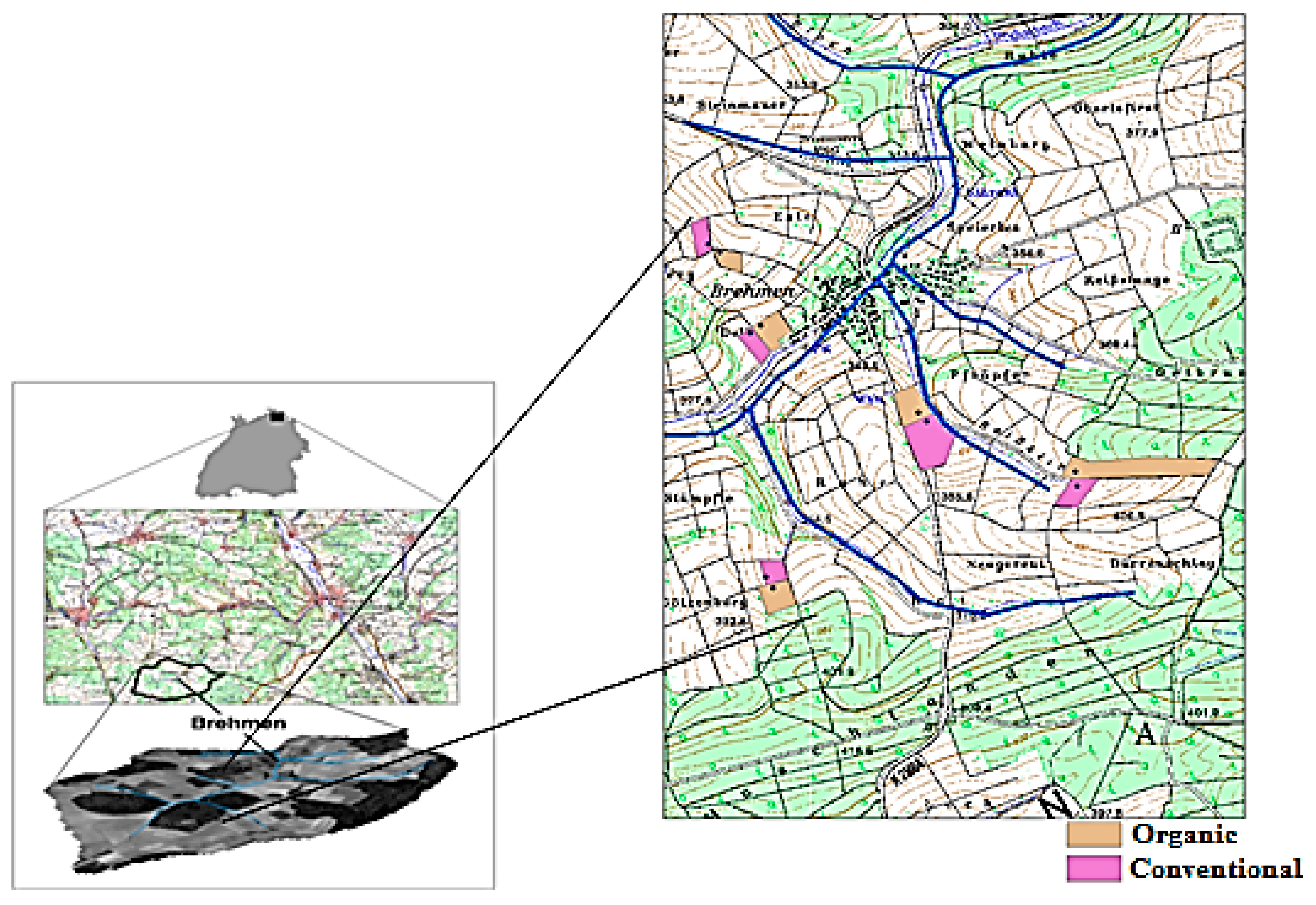
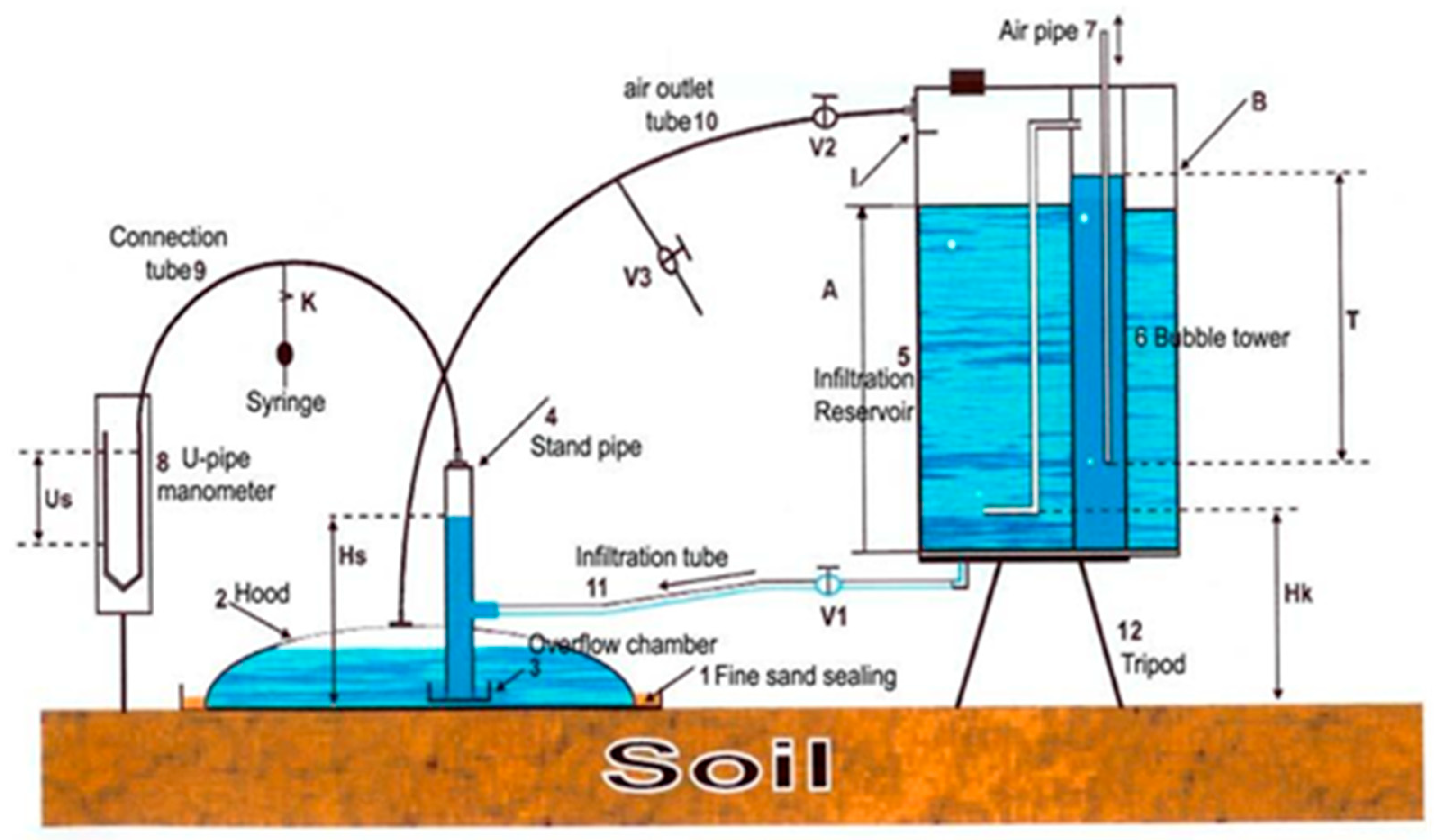

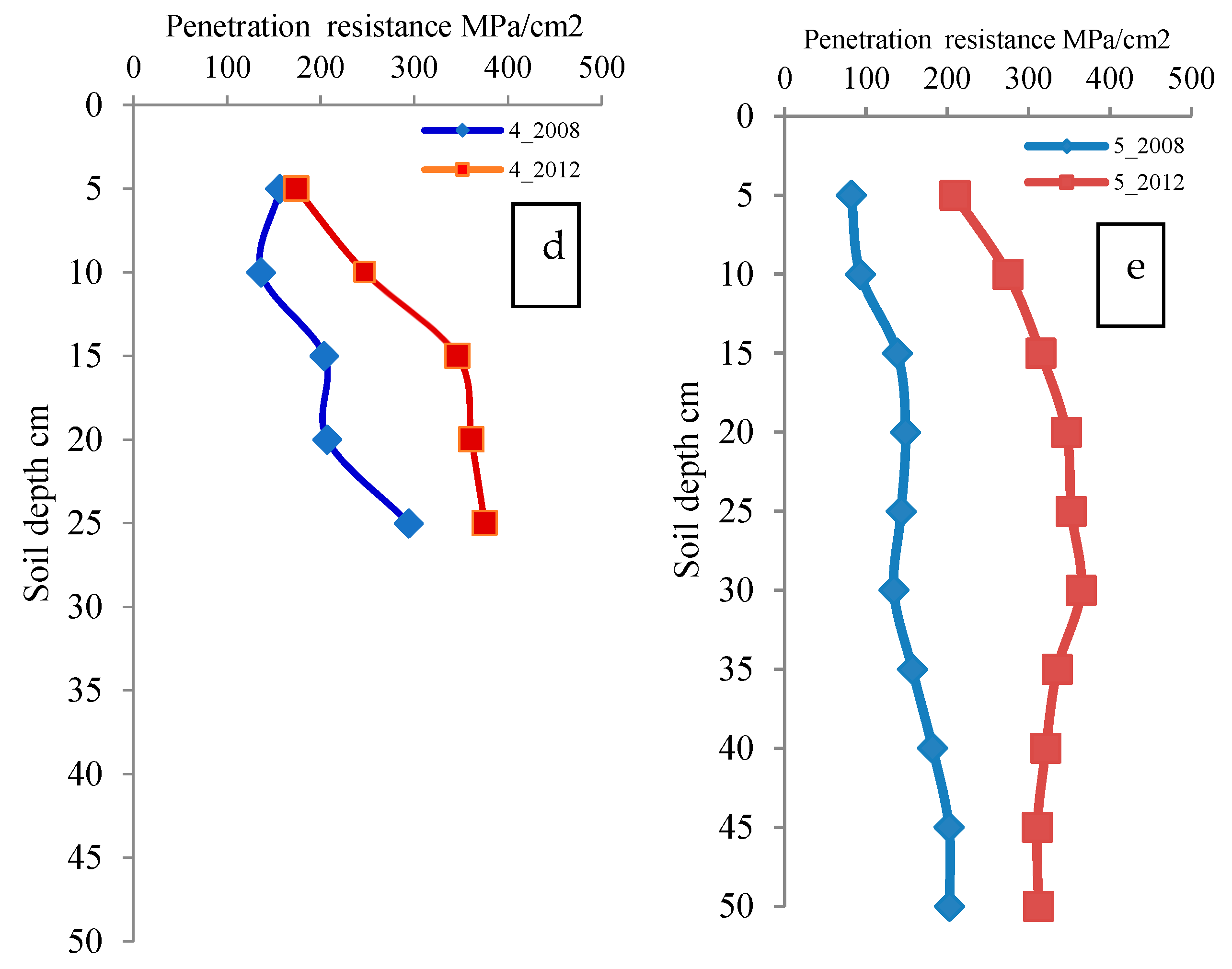
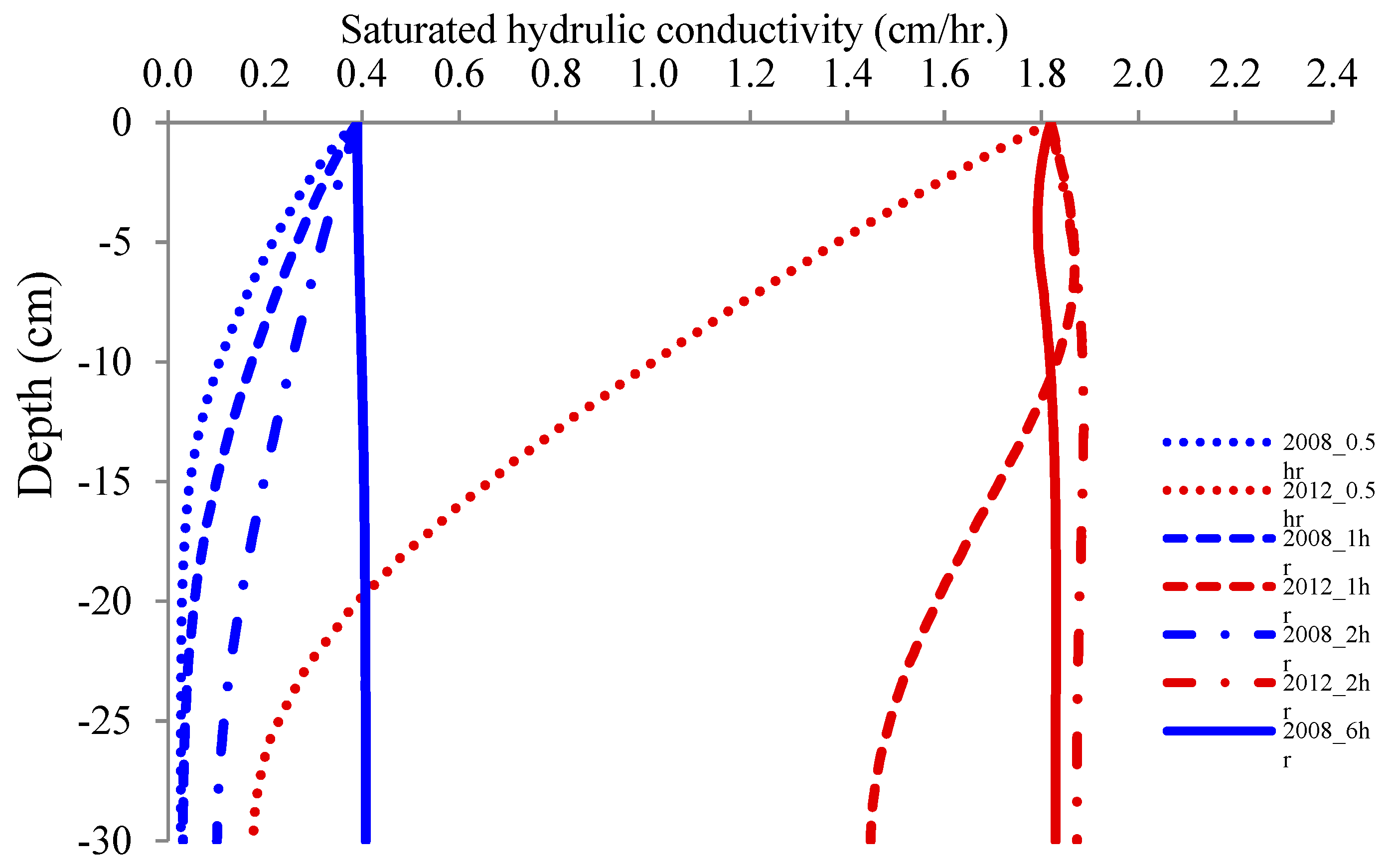
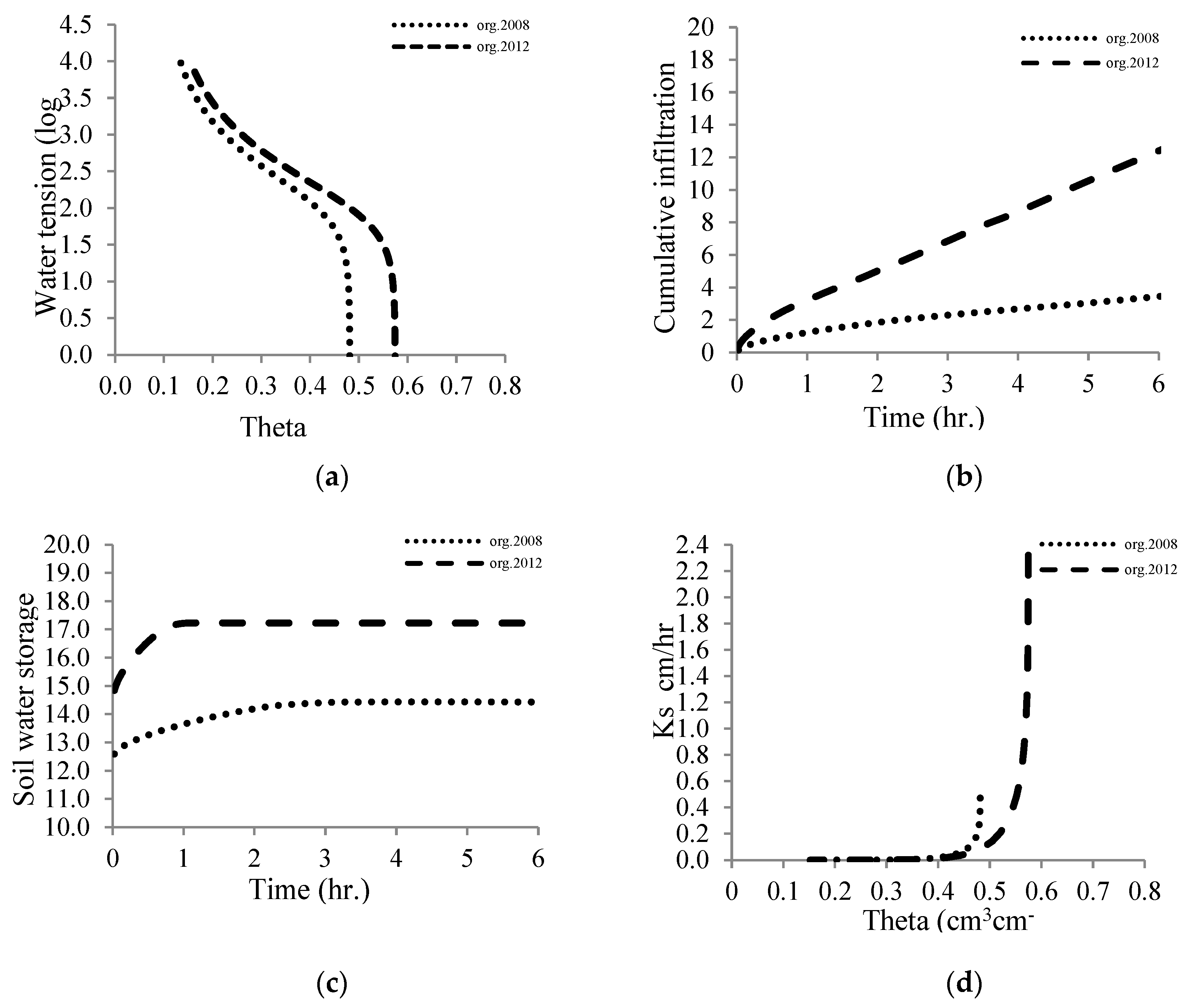
| Sample Location | Crop Type | ||||
|---|---|---|---|---|---|
| 2008 | 2009 | 2010 | 2011 | 2012 | |
| I | Spelt | Flax | Black emmer | Alfalfa | Alfalfa |
| II | Spelt | Sweet pea | Red clover | Red clover | Winter Wheat |
| III | Winter rape | Winter Wheat | Summer barley | Spelt | Barley |
| IV | Oats | Barley | Rye | Summer wheat | Black emmer |
| V | Winter Wheat | Red clover | Red clover | Winter Wheat | Spelt |
| Sample Location | X_Coord | Y_Coord | Soil Management | Particle Size Distribution | Texture | ||
|---|---|---|---|---|---|---|---|
| Sand% | Silt% | Clay% | |||||
| I | 3540422 | 5492031 | Organic | 2.1 | 52.1 | 45.8 | Clay |
| II | 3541030 | 5491781 | Organic | 11.3 | 52.1 | 36.5 | Silty Clay Loam |
| III | 3539854 | 5491288 | Organic | 3.3 | 44.3 | 52 | Clay |
| IV | 3539806 | 5492396 | Organic | 3.3 | 63 | 33.7 | Silty Clay Loam |
| V | 3539646 | 5492708 | Organic | 1.2 | 60.9 | 37.8 | Silty Clay Loam |
| Year | Property | Field Location | ||||
|---|---|---|---|---|---|---|
| I | II | III | IV | V | ||
| 2008 | BD (Mg m−3) | 1.31 | 1.39 | 1.21 | 1.34 | 1.47 |
| eBD (Mg m−3) | 1.72 | 1.72 | 1.68 | 1.64 | 1.81 | |
| qs (cm min−1) | 1.84 | 0.67 | 1.11 | 0.48 | 0.62 | |
| Ks (cm d−1) | 27.06 | 24.42 | 40.46 | 17.49 | 22.59 | |
| 2012 | BD (Mg m−3) | 1.22 | 1.23 | 1.20 | 1.02 | 1.14 |
| eBD (Mg m−3) | 1.63 | 1.56 | 1.67 | 1.32 | 1.48 | |
| qs(cm min−1) | 0.91 | 0.79 | 1.31 | 1.07 | 1.12 | |
| Ks (cm d−1) | 33.17 | 28.79 | 47.75 | 38.99 | 40.82 | |
| Field Management | Soil Type | Theta r (cm3 cm−3) | Theta s (cm3 cm−3) | Alpha (1/cm) | n | Ks (cm.h−1) |
|---|---|---|---|---|---|---|
| Org. (2008) | Silty Clay Loam | 0.091 | 0.481 | 0.09 | 1.502 | 0.472 |
| Org. (2012) | Silty Clay Loam | 0.098 | 0.574 | 0.01 | 1.467 | 2.323 |
Publisher’s Note: MDPI stays neutral with regard to jurisdictional claims in published maps and institutional affiliations. |
© 2022 by the authors. Licensee MDPI, Basel, Switzerland. This article is an open access article distributed under the terms and conditions of the Creative Commons Attribution (CC BY) license (https://creativecommons.org/licenses/by/4.0/).
Share and Cite
Abu-hashim, M.; Lilienthal, H.; Schnug, E.; Kucher, D.E.; Mohamed, E.S. Tempo-Spatial Variations in Soil Hydraulic Properties under Long-Term Organic Farming. Land 2022, 11, 1655. https://doi.org/10.3390/land11101655
Abu-hashim M, Lilienthal H, Schnug E, Kucher DE, Mohamed ES. Tempo-Spatial Variations in Soil Hydraulic Properties under Long-Term Organic Farming. Land. 2022; 11(10):1655. https://doi.org/10.3390/land11101655
Chicago/Turabian StyleAbu-hashim, M., H. Lilienthal, E. Schnug, Dmitry E. Kucher, and Elsayed Said Mohamed. 2022. "Tempo-Spatial Variations in Soil Hydraulic Properties under Long-Term Organic Farming" Land 11, no. 10: 1655. https://doi.org/10.3390/land11101655
APA StyleAbu-hashim, M., Lilienthal, H., Schnug, E., Kucher, D. E., & Mohamed, E. S. (2022). Tempo-Spatial Variations in Soil Hydraulic Properties under Long-Term Organic Farming. Land, 11(10), 1655. https://doi.org/10.3390/land11101655










